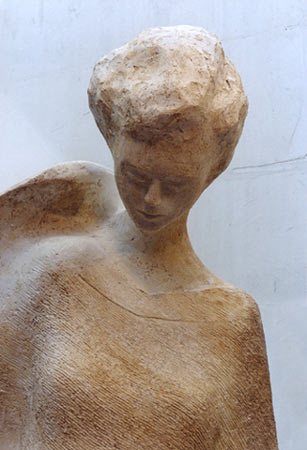|
Why faces both humane and happy ?
Why does this face of Joan of Arc present neither toughness nor suffering ? Why would I have sweetened in her the violence of war, that of the trial and that of the stake ? Why do faces and bodies throughout my whole sculpted work radiate serenity and happiness ? Why do my abstract marbles themselves seem marked by benevolence and harmony ? I take it my hand has a natural proclivity to give a favourable final turn to the work it has in progress. That proclivity, I should say, is rooted in deep old me : as I progress in my work, resilience simultaneously resolves my innermost debates precisely where they bear harshness and torments. “You shall know that your path is the right one from the happiness it provides you with.” Aristotle
Beyond that natural proclivity to positive, optimistic resolution, I further acknowledge a deliberate choice on my part, an intended message in my sculpture. Yet, on that point, I suspect some sort of unbalance, or rather a balance based on a forced strain towards positivity; education, and a whole life of discipline reaching as far back as childhood with frequent ordeals throughout, may be the cause for it. In other words, two deep-rooted habits stir me one after the other: being tougher than evils/being able to make a renewed thirst for life spring.
1)A man tougher than evils is a poor listener of the harms of his body and heart (and, therefore, he finds it hard to get reconciled with himself, since he represses the hardnesses of his life). And although such self-oblivion makes him more accessible to others’ misfortunes and more liable to hear them, more attentive too to the world’s harshnesses, no such item could be better adjusted than if he lent a keener ear to his own misfortunes. With a direct impact on the relevance of his sculpture.
2)Similarly, if his being able to make a renewed thirst for life spring is somewhat forced, if he is positive and optimistic without proper consideration for himself, traces of that, however small, will be found in his way of sculpting.
There lies one of the fundamental issues of my work, the very furtherance of which may be able to resolve.
PS Two qualifying remarks : Listening to others allows a better listening to oneself (cf p.3, 4, 7). And if the risk of mawkishness is inherent in the expression of happiness in sculpture, I daresay that choice is not so easy a path as that of revolt, that of harshness, that of ugliness.
(Translated by Michèle Bustros)
|

JOAN OF ARC
modèle plâtre de la statue de Rouen (1998)
|